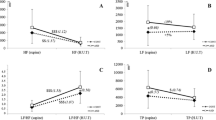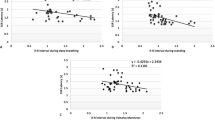Abstract
Autonomic responses to mental tasks requiring sustained attention were examined in individuals with autism and age- and ability-matched controls. Cardiac autonomic function (CAF) was evaluated based on heart rate variability. While the control group showed a significant decrease in the parasympathetic function during mental tasks, the autistic group showed no significant changes in CAF. When examined individually, parasympathetic function was suppressed in all subjects in the control group. On the other hand, parasympathetic function was activated in half of the autistic subjects. The paradoxical autonomic response suggests that some autistic subjects were more stressed under ‘resting’ conditions than while performing mechanical or repetitive mental tasks. The results seem to support autonomic hyperarousal in some people with autism.
Similar content being viewed by others
REFERENCES
American-Psychiatric-Association. (1994). DSM-IV: Diagnostic and Statistical Manual of Mental Disorders. (4th ed.). Washington, D.C.: American Psychiatric Association.
Anderson, L. T., Campbell, M., Grega, D. M., Perry, R., Small, A. M., & Green, W. H. (1984). Haloperidol in the treatment of infantile autism: Effects on learning and behavioral symptoms. American Journal of Psychiatry, 141, 1195–1202.
Angus, Z. (1970). Autonomic and cognitive functions in childhood psychosis. Bulletin of British Psychology Society, 23, 228–229.
Anthony, J. (1958). An experimental approach to the psychopathology of childhood: Autism. British Journal of Medical Psychology, 31, 211–225.
Bachevalier, J. (1994). Medial temporal lobe structures and autism: A review of clinical and experimental findings. Neuropsychologia, 32, 627–648.
Bartak, L., Rutter, M., & Cox, A. (1975). A comparative study of infantile autism and specific developmental receptive language disorder: I. The children. British Journal of Psychiatry, 126, 127–145.
Bernal, M. E., & Miller, W. H. (1971). Electrodermal and cardiac responses of schizophrenic children to sensory stimuli. Psychophysiology, 7, 155–168.
Blitz, P. S., Hoogstraten, J., & Mulder, G. (1970). Mental load, heart rate and heart rate variability. Psychologische Forschung, 33, 277–288.
Cohen, J. D., & Johnson, W. T. (1977). Cardiovascular correlates of attention in normal and psychiatrically disturbed children. Archives of General Psychiatry, 34, 561–567.
Devinsky, O., Morrell, M. J., & Vogt, B. A. (1995). Contributions of anterior cingulate cortex to behaviour. Brain, 118, 279–306.
Ernst, M., Magee, H. J., Gonzalez, N. M., Locascio, J. J., Rosenberg, C. R., & Campbell, M. (1992). Pimozide in autistic children. Psychopharmacological Bulletin, 28, 187–191.
Fein, D., Pennington, B., Markowitz, P., Braverman, M., & Waterhouse, L. (1986). Toward a neuropsychological model of infantile autism: Are the social deficits primary? Journal of the American Academy of Child Psychiatry, 25, 198–212.
Fein, D., Pennington, B., & Waterhouse, L. (1987). Implications of social deficits in autism for neurological dysfunction. In E. Schopler & G. B. Mesibov (Eds.), Neurobiological Issues in Autism, (pp. 127–144). New York: Plenum Press.
Fein, D., Skoff, B., & Mirsky, A. F. (1981). Clinical correlates of brainstem dysfunction in autistic children. Journal of Autism and Developmental Disorders, 11, 303–315.
Findling, R. L., Maxwell, K., & Wiznitzer, M. (1997). An open clinical trial of risperidone monotherapy in young children with autistic disorder. Psychopharmacological Bulletin, 33, 155–159.
Fineman, K. R. (1968). Visual-color reinforcement in establishment of speech by an autistic child. Perceptual and Motor Skills, 26, 761–762.
Goldfarb, W. (1956). Receptor preferences in schizophrenic children. Archives of Neurology and Psychiatry, 76, 643–652.
Graveling, R. A., & Brooke, J. D. (1978). Hormonal and cardiac response of autistic children to changes in environmental stimulation. Journal of Autism and Childhood Schizophrenia, 8, 441–455.
Hayano, J., Sakakibara, Y., Yamada, A., Yamada, M., Mukai, S., Fujinami, T., Yokoyama, K., Watanabe, Y., & Takata, K. (1991). Accuracy of assessment of cardiac vagal tone by heart rate variability in normal subjects. American Journal of Cardiology, 67, l99–204.
Haznedar, M. M., Buchsbaum, M. S., Metzger, M., Solimando, A., Spiegel-Cohen, J., & Hollander, E. (1997). Anterior cingulate gyrus volume and glucose metabolism in autistic disorder. American Journal of Psychiatry, 154, 1047–1050.
Haznedar, M. M., Buchsbaum, M. S., Wei, T. C., Hof, P. R., Cartwright, C., Bienstock, C. A., & Hollander, E. (2000). Limbic circuitry in patients with autism spectrum disorders studied with positron emission tomography and magnetic resonance imaging. American Journal of Psychiatry, 157, 1994–2001.
Hermelin, B., & O'Connor, N. (1968). Measures of the occipital alpha rhythm in normal, subnormal and autistic children. British Journal of Psychiatry, 114, 603–610.
Hutt, C., Forrest, S. J., & Richer, J. (1975). Cardiac arrhythmia and behaviour in autistic children. Acta Psychiatrica Scandinavica, 51, 361–372.
Hutt, C., Hutt, S. J., Lee, D., & Ounsted, C. (1964). Arousal and childhood autism. Nature, 204, 908–909.
Hutt, S. J., Hutt, C., Lee, D., & Ounsted, C. (1965). A behavioural and electroencephalographic study of autistic children. Journal of Psychiatric Research, 3, 181–197.
Hyndman, B. W., & Gregory, J. R. (1975). Spectral analysis of sinus arrhythmia during mental loading. Ergonomics, 18, 255–270.
Kanner, L. (1943). Autistic disturbances of affective contact. Nervous Child, 2, 217–250.
Kodama, H., Shinagawa, F., & Motegi, M. (1982). Japanese Wechsler Intelligence Scale for Children-Revised. Tokyo: Nihon-Bunka-Kagaku-sha.
Kootz, J. P., & Cohen, J. D. (1981). Modulation of sensory intake in autistic children: Cardiovascular and behavioral indices. Journal of American Academy of Child Psychiatry, 20, 692–701.
Kootz, J. P., Marinelli, B., & Cohen, D. J. (1982). Modulation of response to environmental stimulation in autistic children. Journal of Autism and Developmental Disorders, 12, 185–193.
Kubota, Y., Sato, W., Toichi, M., Murai, T., Okada, T., Hayashi, A., & Sengoku, A. (2001). Frontal midline theta rhythm is correlated with cardiac autonomic activities during the performance of an attention demanding meditation procedure. Cognitive Brain Research, 11, 281–287.
Lake, C. R., Ziegler, M. G., & Murphy, D. L. (1977). Increased norepinephrine levels and decreased dopamine-*b-hydroxylase activity in primary autism. Archives of General Psychiatry, 34, 553–556.
Lucini, D., Covacci, G., Milani, R., Mela, G. S., Malliani, A., & Pagani, M. (1997). A controlled study of the effects of mental relaxation on autonomic excitatory responses in healthy subjects. Psychosomatic Medicine, 59, 541–552.
MacCulloch, M. J., & Williams, C. (1971). On the nature of infantile autism. Acta Psychiatrica Scandinavica, 47, 295–314.
Mesulam, M. M. (1981). A cortical network for directed attention and unilateral neglect. Annals of Neurology, 10, 309–325.
Metz, J. R. (1967). Stimulation level preferences of autistic children. Journal of Abnormal Psychology, 72, 529–535.
Newlin, D. B., Wong, C. J., Stapleton, J. M., & London, E. D. (2000). Intravenous cocaine decreases cardiac vagal tone, vagal index (derived in Lorenz space), and heart period complexity (approximate entropy) in cocaine abusers. Neuropsychopharmacology, 23, 560–568.
Ornitz, E., & Ritvo, E. R. (1976). Medical Assessment. In E. R. Ritvo (Ed.), Autism. Diagnosis, current research and management, (pp. 7–23). New York: Spectrum Publications.
Ornitz, E. M. (1974). The modulation of sensory input and motor output in autistic children. Journal of Autism and Childhood Schizophrenia, 4, 197–215.
Ornitz, E. M., & Ritvo, E. R. (1968a). Neurophysiologic mechanisms underlying perceptual inconstancy in autistic and schizophrenic children. Archives of General Psychiatry, 19, 22–27.
Ornitz, E. M., & Ritvo, E. R. (1968b). Perceptual inconstancy in early infantile autism. Archives of General Psychiatry, 18, 76–98.
Pagani, M., Furlan, R., Pizzinelli, P., Crivellaro, W., Cerutti, S., & Malliani, A. (1989). Spectral analysis of R-R and arterial pressure variabilities to assess sympatho-vagal interaction during mental stress in humans. Journal of Hypertension, 7, S14-S15.
Pagani, M., Lombardi, F., Guzzetti, S., Rimoldi, O., Furlan, R., Pizzinelli, P., Sandrone, G., Malfatto, G., Dell'Orto, S., Piccaluga, E., Turiel, M., Baselli, G., Cerutti, S., & Malliani, A. (1986). Power spectral analysis of heart rate and arterial pressure variabilities as a marker of sympatho-vagal interaction in man and conscious dog. Circulation Research, 59, l78–193.
Palkovitz, R. J., & Wiesenfeld, A. R. (1980). Differential autonomic responses of autistic and normal children. Journal of Autism and Developmental Disorders, 10, 347–360.
Perry, R., Campbell, M., Adams, P., Lynch, N., Spencer, E. K., Curren, E. L., & Overall, J. E. (1989). Long-term efficacy of haloperidol in autistic children: Continuous versus discontinuous drug administration. Journal of American Academy of Child and Adolescent Psychiatry, 28, 87–92.
Posner, M. I., Petersen, S. E., Fox, P. T., & Raichle, M. E. (1988). Localization of cognitive operations in the human brain. Science, 240, 1627–1631.
Raven, J. C. (1960). Standard Progressive Matrices: Sets A, B, C, D and E. London: H. K. Lewis.
Raven, J. C. (1962). Coloured Progressive Matrices: Sets A, AB, B. London: H. K. Lewis.
Raven, J. C., Court, J. H., & Raven, J. (1995). Section 2. Coloured Progressive Matrices. (1995 edition). Oxford: Oxford Psychologists Press.
Rimland, B. (1964). Infantile autism. The syndrome and its implication for a natural theory of behavior. New York: Meredith Publishing Company.
Robbins, T. W., & Everitt, B. J. (1995). Arousal system and attention. In M. S. Gazzaniga (ed.), The Cognitive Neurosciences, (pp. 703–720). Cambridge, MA: MIT Press.
Rosenblum, S. M., Arick, J. R., Krug, D. A., Stubbs, E. G., Young, N. B., & Pelson, R. O. (1980). Auditory brainstem evoked responses in autistic children. Journal of Autism and Developmental Disorders, 10, 215–225.
Rutter, M. (1968). Concept of autism: A review of research. Journal of Child Psychology and Psychiatry, 9, 1–25.
Rutter, M., & Bartak, L. (1971). Causes of infantile autism: Some considerations from recent research. Journal of Autism and Childhood Schizophrenia, 1, 20–32.
Schechter, M. D., Shurley, J. T., Toussieng, P. W., & Maier, W. J. (1969). Sensory isolation therapy of autistic children: A preliminary report. Journal of Pediatrics, 74, 564–569.
Schopler, E. (1965). Early infantile autism and receptor processes. Archives of General Psychiatry, 13, 327–335.
Shinagawa, F., Kobayashi, S., Fujita, K., & Maegawa, H. (1990). Japanese Wechsler Adult Intelligence Scale-Revised. Tokyo: Nihon-Bunka-Kagaku-sha.
Stevens, M. C., Fein, D. A., Dunn, M., Allen, D., Waterhouse, L. H., Feinstein, C., & Rapin, I. (2000). Subgroups of children with autism by cluster analysis: A longitudinal examination. Journal of the American Academy of Child and Adolescent Psychiatry, 39, 346–352.
Stevens, S., & Gruzelier, J. (1984). Electrodermal activity to auditory stimuli in autistic, retarded, and normal children. Journal of Autism and Developmental Disorders, 14, 245–260.
Student, M., & Sohmer, H. (1978). Evidence from auditory nerve and brainstem evoked responses for an organic brain lesion in children with autistic traits. Journal of Autism and Childhood Schizophrenia, 8, 13–20.
Task Force of the European Society of Cardiology and the North American Society of Pacing and Electrophysiology (1996). Heart rate variability. Standards of measurement, physiological interpretation, and clinical use. Circulation, 93, 1043–1065.
Toichi, M., Kubota, Y., Toshiya, M., Kamio, Y., Sakihama, M., Toriuchi, T., Inakuma, T., Sengoku, A., & Miyoshi, K. (1999). The influence of psychotic states on the autonomic nervous system in schizophrenia. International Journal of Psychophysiology, 31, 147–154.
Toichi, M., Murai, T., Sengoku, A., & Miyoshi, K. (1998). Interictal change in cardiac autonomic function associated with EEG abnormalities and clinical symptoms: A longitudinal study following acute deterioration in two patients with temporal lobe epilepsy. Psychiatry and Clinical Neurosciences, 52, 499–505.
Toichi, M., Sugiura, T., Murai, T., & Sengoku, A. (1997). A new method of assessing cardiac autonomic function and its comparison with spectral analysis and coefficient of variation of R-R interval. Journal of the Autonomic Nervous System, 62, 79–84.
Van Engeland, H. (1984). The electrodermal orienting response to auditive stimuli in autistic children, mentally retarded children, and child psychiatric patients. Journal of Autism and Developmental Disorders, 14, 261–279.
Young, J. G., Cohen, D. J., Brown, S., & Caparulo, B. K. (1978). Decreased urinary free catecholamines in childhood autism. Journal of American Academy of Child Psychiatry, 17, 671–678.
Zahn, T. P., Rumsey, J. M., & Van Kammen, D. P. (1987). Autonomic nervous system activity in autistic, schizophrenic, and normal men: Effects of stimulus significance. Journal of Abnormal Psychology, 96, 135–144.
Author information
Authors and Affiliations
Corresponding author
Rights and permissions
About this article
Cite this article
Toichi, M., Kamio, Y. Paradoxical Autonomic Response to Mental Tasks in Autism. J Autism Dev Disord 33, 417–426 (2003). https://doi.org/10.1023/A:1025062812374
Issue Date:
DOI: https://doi.org/10.1023/A:1025062812374




